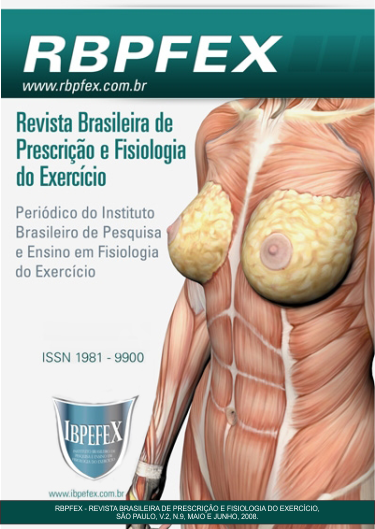Profile of the injuries in skate practitioners
Abstract
Brazil is the second largest world power in the skate, the increase in popularity of this practice sports has brought high incidence in the occurrence of musculoskeletal disorders. Objective: To verify the locations of the human body where the injuries occur in the skate, what types of injuries frequently and in moments of the practice which this occurs. Materials and methods: We have recruited 21 volunteers, all of the males, were included athletes aged between 15 and 35 years, with time to practice from less than 1 year to more than 10. These volunteers answered a questionnaire containing 23 questions. Results: The ankle sprain, represented 24% of all injuries, fractures of the ulna 18%, the dislocations of 14% wrist, injuries accounted for 11% in the knee, the fractures of phalanges with 7%, the dislocation of elbow represented 7 % and 7% of the humerus fractures, fractures of the fibula 4%, 4% fractures of ribs and fractures radio accounted for 4%. Discussion: The number and profile of injuries found in this study are present in other sports not considered radicals. Conclusion: 76% of the athletes interviewed reported having suffered some type of injury during practice sports. The injuries of the ankle were the most frequent (24%), followed by the ulna fracture (18%). Even the skate is considered a radical sport, the number of lesions found not differ much of the lesions found in other sports.
References
Arena, S.S.; Estudo Epidemiológico das Lesões Esportivas no Basquetebol, Futsal e Voleibol Ocorridas em Atletas Jovens: Aspectos de Treinamento e Acompanhamento Médico. Tese apresentada a Universidade de São Paulo, Faculdade de Medicina, Departamento de Ortopedia e Traumatologia para obtenção do grau de Doutor. São Paulo;. Pág. 125. 2005.
Britto, E.; A Onda Dura: Três Décadas de Skate no Brasil. 1ª edição. São Paulo. Parada Inglesa. 2000.
Ferreira, P.H.; A Eficácia de Tornozeleiras e Bandagens Funcionais no Controle do Equilíbrio Dinâmico. Revista Fisioterapia em Movimento. Paraná. Vol. 10. Num. 2. Outubro de 1997-março 1998. P. 20-30.
Gantus, Mario Cardoso; Assumpção, Jurandyr D'Ávila; Epidemiologia das Lesões do Sistema Locomotor em Atletas de Basquetebol. Acta fisiátrica. São Paulo. Vol. 9. Num. 2. Agosto 2002. P. 77-84.
Http/www.cbs.com.br. Confederação Brasileira de Skate. Acesso em 12/08/2007.
Laurindo, C.F. de S.; Lopes, A.D.; Mano, K. da S.; Cohen, M.; Abdalla, R.J.; Lesões Músculo-Esqueléticas no Atletismo. Revista Brasileira de Ortopedia. São Paulo. Vol. 35. Num. 9. Setembro 2000. P. 364-368.
Leite, Cláudia Batista Siqueira; Cavalcanti Neto, Florêncio Figueiredo.; Incidência de Lesões Traumato-Ortopédicas no Futebol de Campo Feminino e sua Relação com Alterações Posturais. Revista Digital Efdeportes. Buenos Aires. Ano 9. Num. 61. Junho de 2003.
Petri, Fábio César; Rodrigues, Reynaldo Costa; Cohen, Moisés; Abdalla, René Jorge; Lesões Músculo-Esqueléticas Relacionadas com a Prática do Tênis de Mesa. Revista Brasileira de Ortopedia. São Paulo. Vol. 37. Num. 8. Agosto 2002. P. 358-362.
Silva, Alexandre Sabbag da; Abdalla, Rene Jorge; Fisberg, Mauro. Incidência de Lesões Músculo-Esqueléticas em Atletas de Elite do Basquetebol Feminino. Acta Ortopédica Brasileira. São Paulo. Vol. 15. Num. 1. 2007. Pág. 43-46.
Authors who publish in this journal agree to the following terms:
- Authors retain the copyright and grant the journal the right of first publication, with work simultaneously licensed under the Creative Commons Attribution License BY-NC which allows the sharing of the work with acknowledgment of the authorship of the work and initial publication in this journal.
- Authors are authorized to enter into additional contracts separately for non-exclusive distribution of the version of the work published in this journal (eg, publishing in institutional repository or book chapter), with acknowledgment of authorship and initial publication in this journal.
- Authors are allowed and encouraged to post and distribute their work online (eg, in institutional repositories or on their personal page) at any point before or during the editorial process, as this can bring about productive change as well as increase impact and impact. citation of published work (See The Effect of Free Access).






